tow Acura ZDX 2012 User Guide
[x] Cancel search | Manufacturer: ACURA, Model Year: 2012, Model line: ZDX, Model: Acura ZDX 2012Pages: 645, PDF Size: 16.36 MB
Page 520 of 645
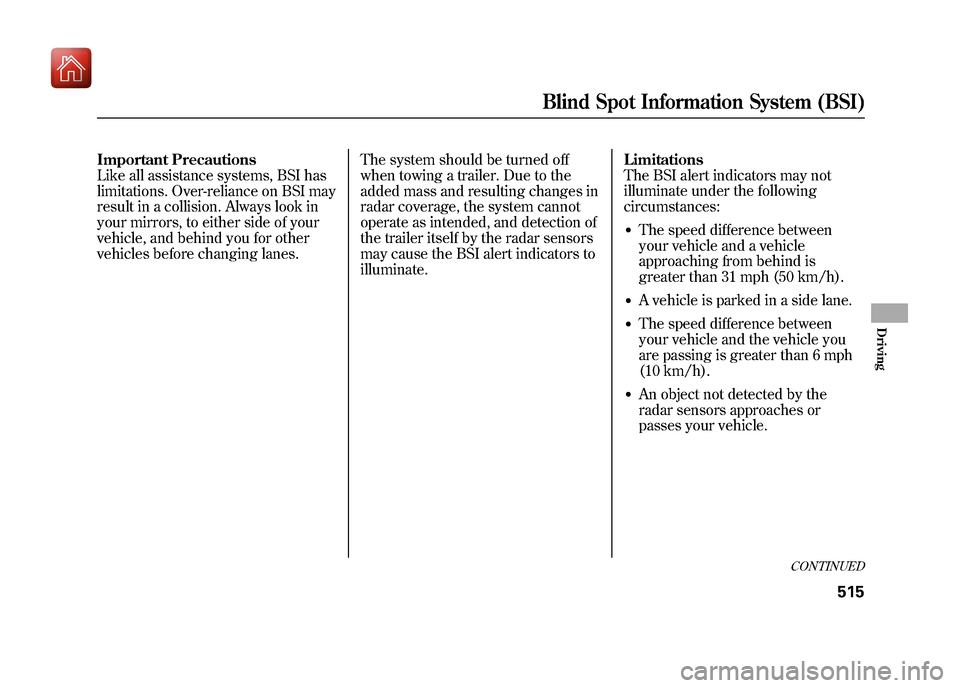
Important Precautions
Like all assistance systems, BSI has
limitations. Over-reliance on BSI may
result in a collision. Always look in
your mirrors, to either side of your
vehicle, and behind you for other
vehicles before changing lanes.The system should be turned off
when towing a trailer. Due to the
added mass and resulting changes in
radar coverage, the system cannot
operate as intended, and detection of
the trailer itself by the radar sensors
may cause the BSI alert indicators to
illuminate.Limitations
The BSI alert indicators may not
illuminate under the following
circumstances:
●The speed difference between
your vehicle and a vehicle
approaching from behind is
greater than 31 mph (50 km/h).●A vehicle is parked in a side lane.●The speed difference between
your vehicle and the vehicle you
are passing is greater than 6 mph
(10 km/h).●An object not detected by the
radar sensors approaches or
passes your vehicle.
CONTINUED
Blind Spot Information System (BSI)
515
Driving
09/10/28 17:15:37 10 ACURA ZDX KA KC New North America Own 50 31SZN600 enu
Page 521 of 645
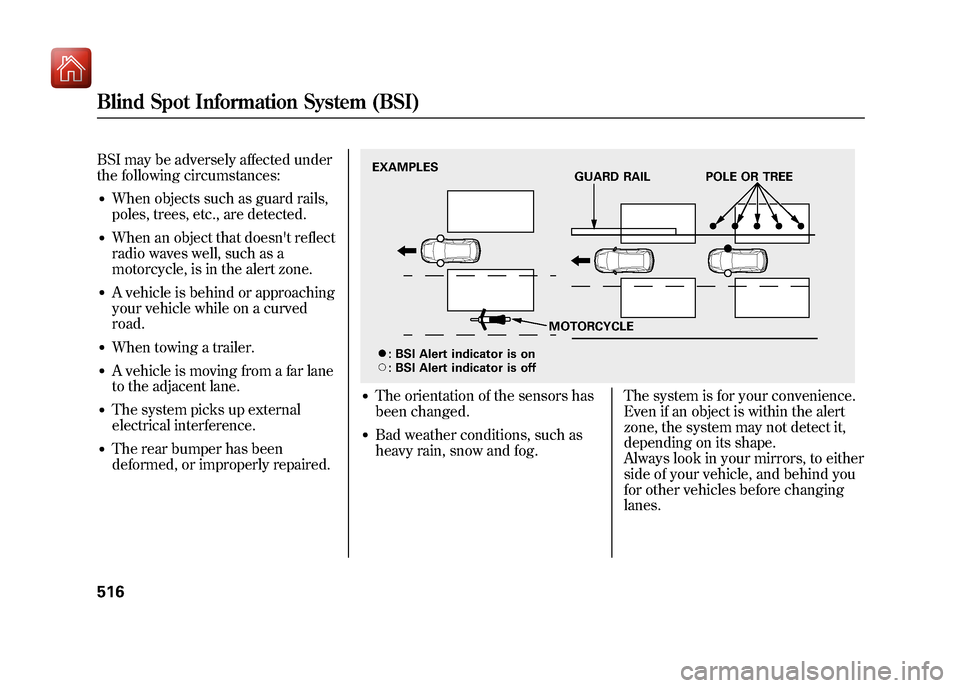
BSI may be adversely affected under
the following circumstances:●When objects such as guard rails,
poles, trees, etc., are detected.●When an object that doesn't reflect
radio waves well, such as a
motorcycle, is in the alert zone.●A vehicle is behind or approaching
your vehicle while on a curved
road.●When towing a trailer.●A vehicle is moving from a far lane
to the adjacent lane.●The system picks up external
electrical interference.●The rear bumper has been
deformed, or improperly repaired.
●The orientation of the sensors has
been changed.●Bad weather conditions, such as
heavy rain, snow and fog.The system is for your convenience.
Even if an object is within the alert
zone, the system may not detect it,
depending on its shape.
Always look in your mirrors, to either
side of your vehicle, and behind you
for other vehicles before changing
lanes.EXAMPLES
GUARD RAIL POLE OR TREE
MOTORCYCLE
ꭍ :
\b :BSI Alert indicator is on
BSI Alert indicator is off
Blind Spot Information System (BSI)51609/10/28 17:15:37 10 ACURA ZDX KA KC New North America Own 50 31SZN600 enu
Page 527 of 645
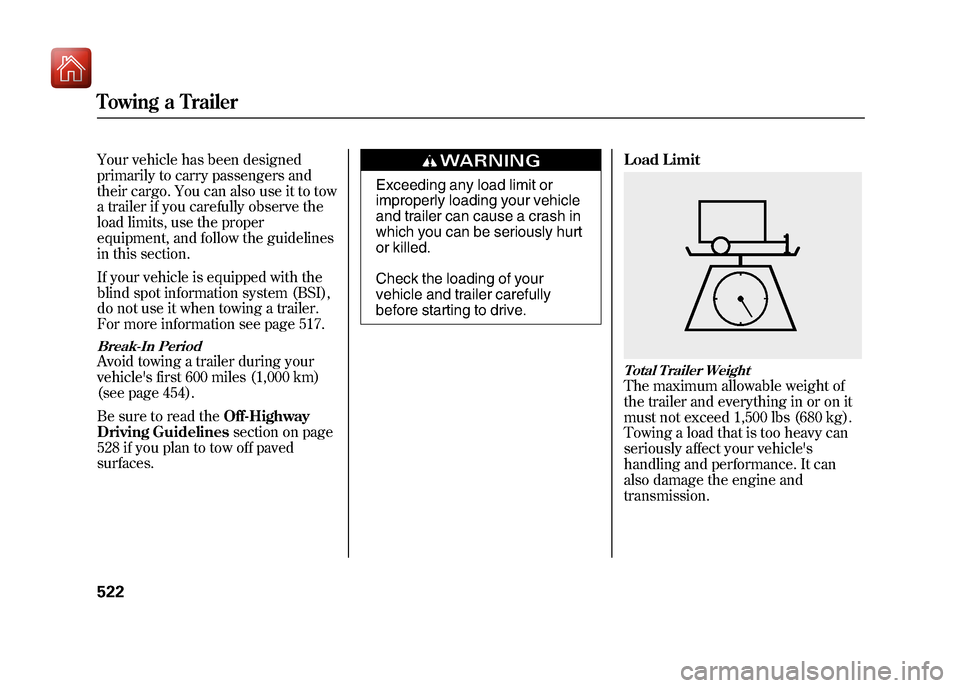
Your vehicle has been designed
primarily to carry passengers and
their cargo. You can also use it to tow
a trailer if you carefully observe the
load limits, use the proper
equipment, and follow the guidelines
in this section.
If your vehicle is equipped with the
blind spot information system (BSI),
do not use it when towing a trailer.
For more information see page 517.Break-In PeriodAvoid towing a trailer during your
vehicle's first 600 miles (1,000 km)
(see page 454).
Be sure to read theOff-Highway
Driving Guidelines section on page
528 if you plan to tow off paved
surfaces.
Exceeding any load limit or
improperly loading your vehicle
and trailer can cause a crash in
which you can be seriously hurt
or killed.
Check the loading of your
vehicle and trailer carefully
before starting to drive. Load Limit
Total Trailer WeightThe maximum allowable weight of
the trailer and everything in or on it
must not exceed 1,500 lbs (680 kg).
Towing a load that is too heavy can
seriously affect your vehicle's
handling and performance. It can
also damage the engine and
transmission.
Towing a Trailer52209/10/28 17:15:37 10 ACURA ZDX KA KC New North America Own 50 31SZN600 enu
Page 528 of 645
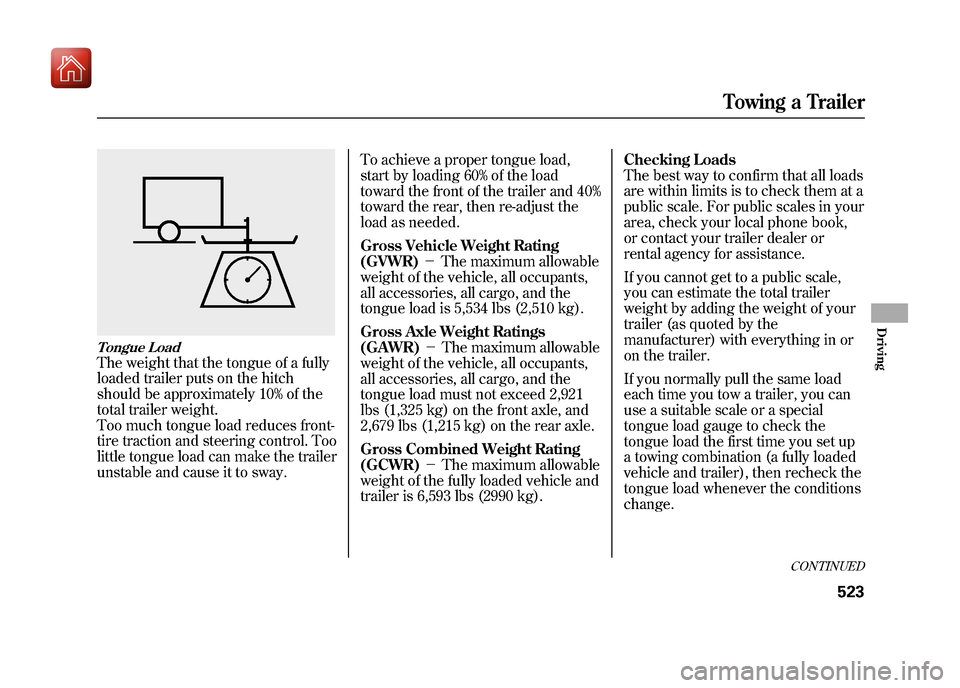
Tongue LoadThe weight that the tongue of a fully
loaded trailer puts on the hitch
should be approximately 10% of the
total trailer weight.
Too much tongue load reduces front-
tire traction and steering control. Too
little tongue load can make the trailer
unstable and cause it to sway.To achieve a proper tongue load,
start by loading 60% of the load
toward the front of the trailer and 40%
toward the rear, then re-adjust the
load as needed.
Gross Vehicle Weight Rating
(GVWR)
-The maximum allowable
weight of the vehicle, all occupants,
all accessories, all cargo, and the
tongue load is 5,534 lbs (2,510 kg).
Gross Axle Weight Ratings
(GAWR) -The maximum allowable
weight of the vehicle, all occupants,
all accessories, all cargo, and the
tongue load must not exceed 2,921
lbs (1,325 kg) on the front axle, and
2,679 lbs (1,215 kg) on the rear axle.
Gross Combined Weight Rating
(GCWR) -The maximum allowable
weight of the fully loaded vehicle and
trailer is 6,593 lbs (2990 kg). Checking Loads
The best way to confirm that all loads
are within limits is to check them at a
public scale. For public scales in your
area, check your local phone book,
or contact your trailer dealer or
rental agency for assistance.
If you cannot get to a public scale,
you can estimate the total trailer
weight by adding the weight of your
trailer (as quoted by the
manufacturer) with everything in or
on the trailer.
If you normally pull the same load
each time you tow a trailer, you can
use a suitable scale or a special
tongue load gauge to check the
tongue load the first time you set up
a towing combination (a fully loaded
vehicle and trailer), then recheck the
tongue load whenever the conditions
change.
CONTINUED
Towing a Trailer
523
Driving
09/10/28 17:15:37 10 ACURA ZDX KA KC New North America Own 50 31SZN600 enu
Page 529 of 645
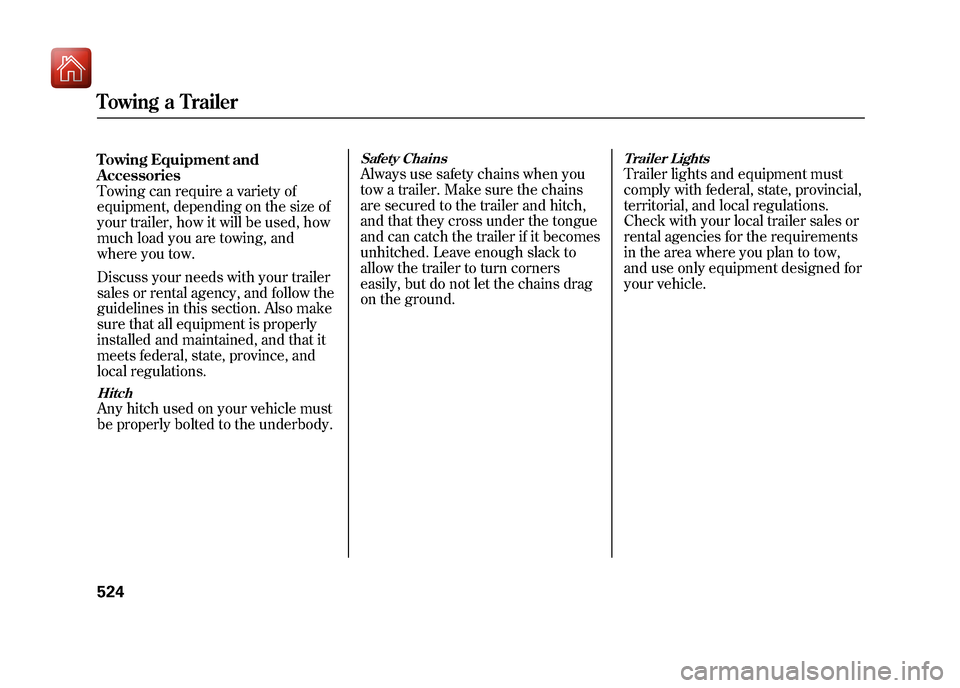
Towing Equipment and
Accessories
Towing can require a variety of
equipment, depending on the size of
your trailer, how it will be used, how
much load you are towing, and
where you tow.
Discuss your needs with your trailer
sales or rental agency, and follow the
guidelines in this section. Also make
sure that all equipment is properly
installed and maintained, and that it
meets federal, state, province, and
local regulations.HitchAny hitch used on your vehicle must
be properly bolted to the underbody.
Safety ChainsAlways use safety chains when you
tow a trailer. Make sure the chains
are secured to the trailer and hitch,
and that they cross under the tongue
and can catch the trailer if it becomes
unhitched. Leave enough slack to
allow the trailer to turn corners
easily, but do not let the chains drag
on the ground.
Trailer LightsTrailer lights and equipment must
comply with federal, state, provincial,
territorial, and local regulations.
Check with your local trailer sales or
rental agencies for the requirements
in the area where you plan to tow,
and use only equipment designed for
your vehicle.
Towing a Trailer52409/10/28 17:15:37 10 ACURA ZDX KA KC New North America Own 50 31SZN600 enu
Page 530 of 645
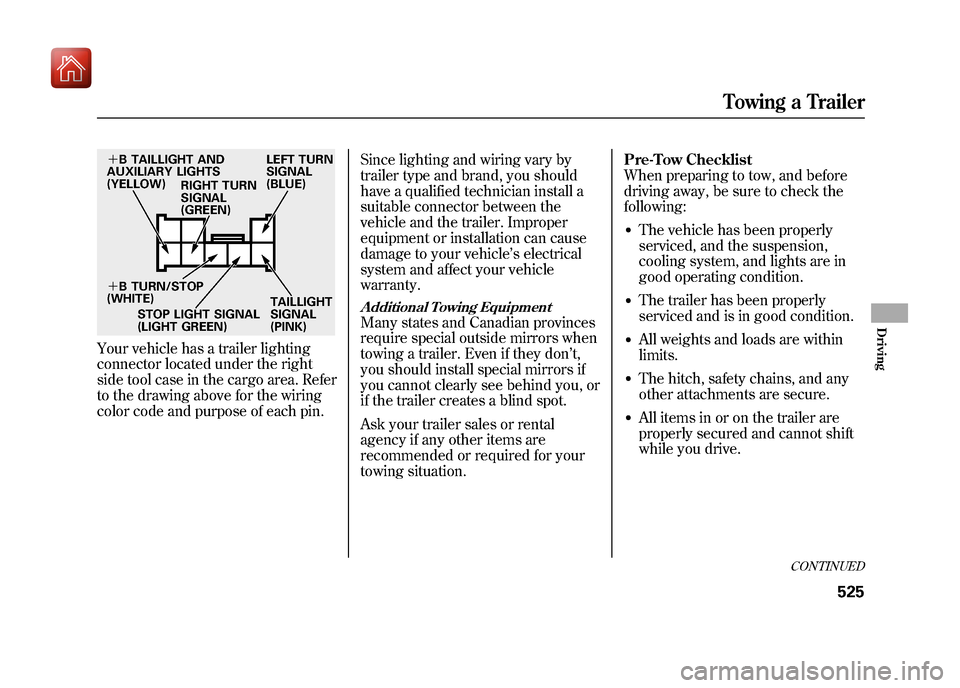
Your vehicle has a trailer lighting
connector located under the right
side tool case in the cargo area. Refer
to the drawing above for the wiring
color code and purpose of each pin.Since lighting and wiring vary by
trailer type and brand, you should
have a qualified technician install a
suitable connector between the
vehicle and the trailer. Improper
equipment or installation can cause
damage to your vehicle
’s electrical
system and affect your vehicle
warranty.
Additional Towing EquipmentMany states and Canadian provinces
require special outside mirrors when
towing a trailer. Even if they don ’t,
you should install special mirrors if
you cannot clearly see behind you, or
if the trailer creates a blind spot.
Ask your trailer sales or rental
agency if any other items are
recommended or required for your
towing situation. Pre-Tow Checklist
When preparing to tow, and before
driving away, be sure to check the
following:
●The vehicle has been properly
serviced, and the suspension,
cooling system, and lights are in
good operating condition.●The trailer has been properly
serviced and is in good condition.●All weights and loads are within
limits.●The hitch, safety chains, and any
other attachments are secure.●All items in or on the trailer are
properly secured and cannot shift
while you drive.
+
B TAILLIGHT AND
AUXILIARY LIGHTS
(YELLOW) RIGHT TURN
SIGNAL
(GREEN) LEFT TURN
SIGNAL
(BLUE)
+ B TURN/STOP
(WHITE)
STOP LIGHT SIGNAL
(LIGHT GREEN) TAILLIGHT
SIGNAL
(PINK)
CONTINUED
Towing a Trailer
525
Driving
09/10/28 17:15:37 10 ACURA ZDX KA KC New North America Own 50 31SZN600 enu
Page 531 of 645
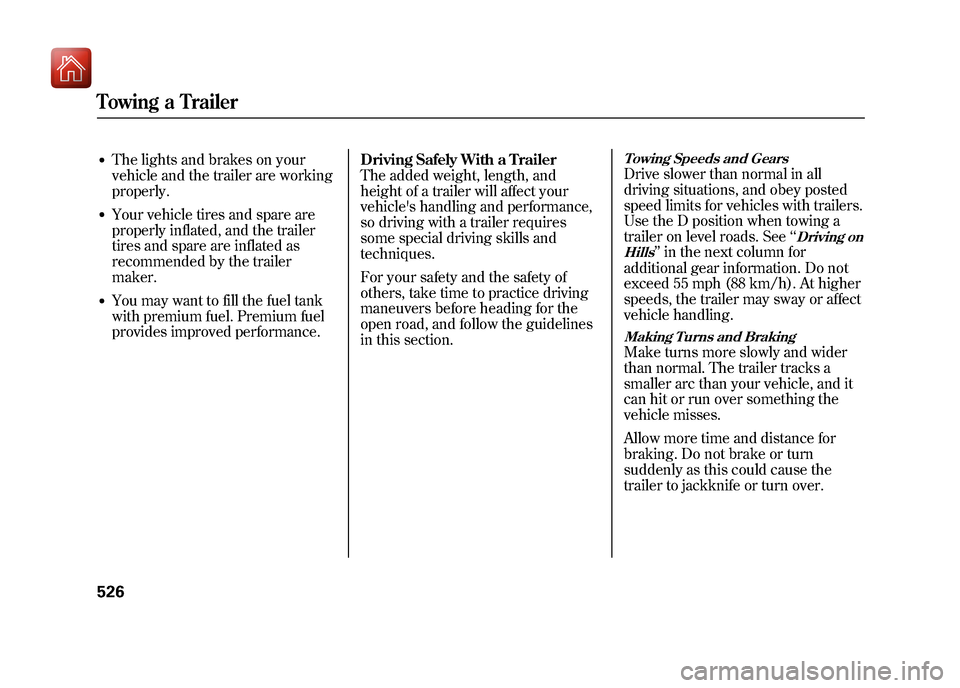
●The lights and brakes on your
vehicle and the trailer are working
properly.●Your vehicle tires and spare are
properly inflated, and the trailer
tires and spare are inflated as
recommended by the trailer
maker.●You may want to fill the fuel tank
with premium fuel. Premium fuel
provides improved performance.Driving Safely With a Trailer
The added weight, length, and
height of a trailer will affect your
vehicle's handling and performance,
so driving with a trailer requires
some special driving skills and
techniques.
For your safety and the safety of
others, take time to practice driving
maneuvers before heading for the
open road, and follow the guidelines
in this section.
Towing Speeds and GearsDrive slower than normal in all
driving situations, and obey posted
speed limits for vehicles with trailers.
Use the D position when towing a
trailer on level roads. See
‘‘
Driving on
Hills
’’ in the next column for
additional gear information. Do not
exceed 55 mph (88 km/h). At higher
speeds, the trailer may sway or affect
vehicle handling.
Making Turns and BrakingMake turns more slowly and wider
than normal. The trailer tracks a
smaller arc than your vehicle, and it
can hit or run over something the
vehicle misses.
Allow more time and distance for
braking. Do not brake or turn
suddenly as this could cause the
trailer to jackknife or turn over.
Towing a Trailer52609/10/28 17:15:37 10 ACURA ZDX KA KC New North America Own 50 31SZN600 enu
Page 532 of 645
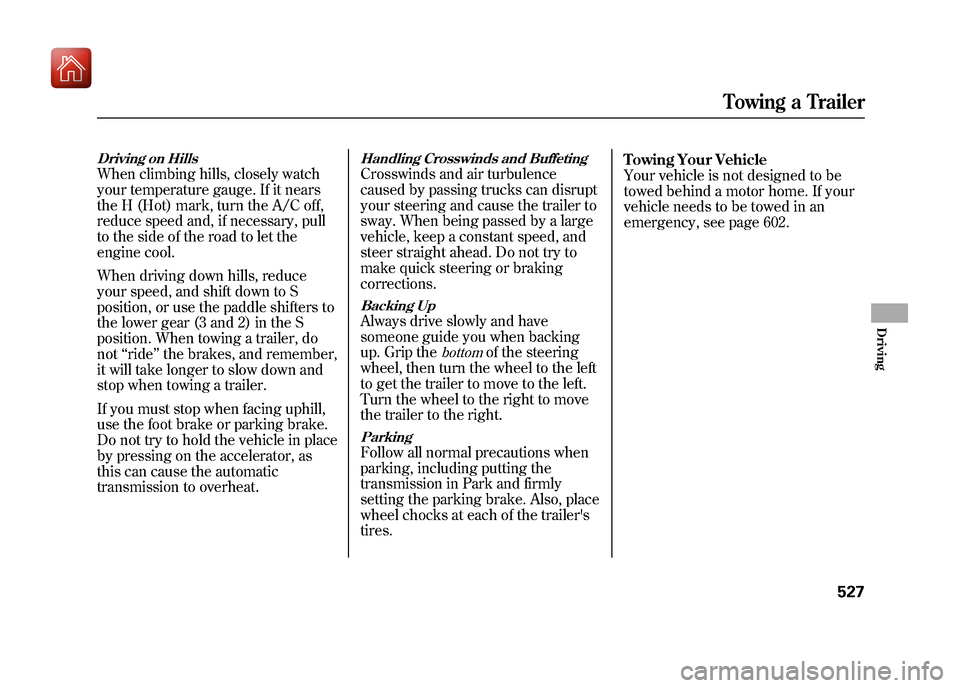
Driving on HillsWhen climbing hills, closely watch
your temperature gauge. If it nears
the H (Hot) mark, turn the A/C off,
reduce speed and, if necessary, pull
to the side of the road to let the
engine cool.
When driving down hills, reduce
your speed, and shift down to S
position, or use the paddle shifters to
the lower gear (3 and 2) in the S
position. When towing a trailer, do
not‘‘ride ’’the brakes, and remember,
it will take longer to slow down and
stop when towing a trailer.
If you must stop when facing uphill,
use the foot brake or parking brake.
Do not try to hold the vehicle in place
by pressing on the accelerator, as
this can cause the automatic
transmission to overheat.
Handling Crosswinds and BuffetingCrosswinds and air turbulence
caused by passing trucks can disrupt
your steering and cause the trailer to
sway. When being passed by a large
vehicle, keep a constant speed, and
steer straight ahead. Do not try to
make quick steering or braking
corrections.Backing UpAlways drive slowly and have
someone guide you when backing
up. Grip the
bottom
of the steering
wheel, then turn the wheel to the left
to get the trailer to move to the left.
Turn the wheel to the right to move
the trailer to the right.
ParkingFollow all normal precautions when
parking, including putting the
transmission in Park and firmly
setting the parking brake. Also, place
wheel chocks at each of the trailer's
tires. Towing Your Vehicle
Your vehicle is not designed to be
towed behind a motor home. If your
vehicle needs to be towed in an
emergency, see page 602.
Towing a Trailer
527
Driving
09/10/28 17:15:37 10 ACURA ZDX KA KC New North America Own 50 31SZN600 enu
Page 535 of 645
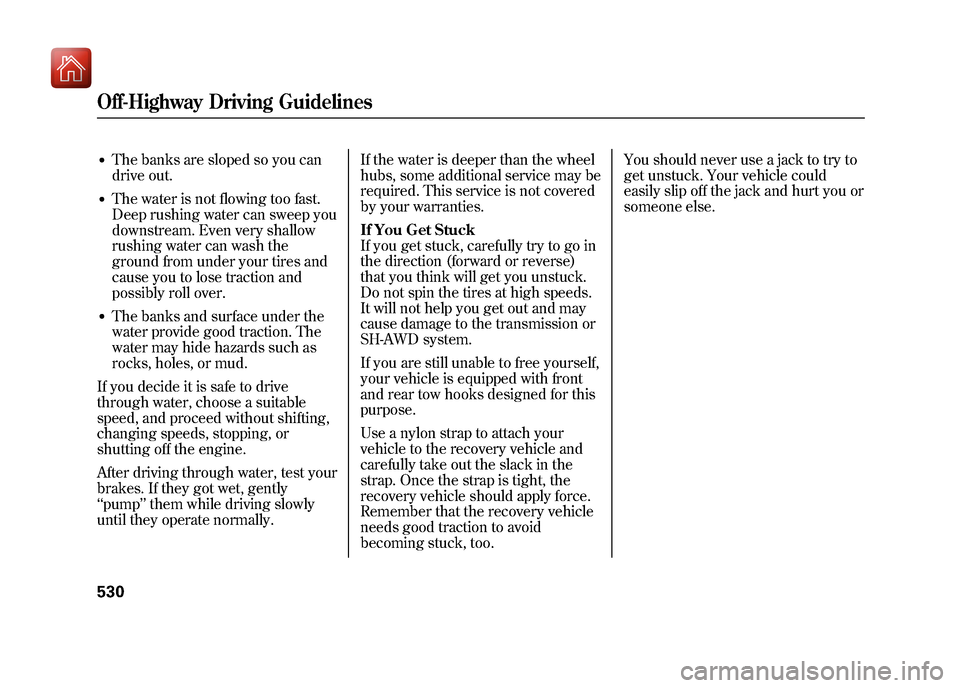
●The banks are sloped so you can
drive out.●The water is not flowing too fast.
Deep rushing water can sweep you
downstream. Even very shallow
rushing water can wash the
ground from under your tires and
cause you to lose traction and
possibly roll over.●The banks and surface under the
water provide good traction. The
water may hide hazards such as
rocks, holes, or mud.
If you decide it is safe to drive
through water, choose a suitable
speed, and proceed without shifting,
changing speeds, stopping, or
shutting off the engine.
After driving through water, test your
brakes. If they got wet, gently
‘‘ pump ’’them while driving slowly
until they operate normally. If the water is deeper than the wheel
hubs, some additional service may be
required. This service is not covered
by your warranties.
If You Get Stuck
If you get stuck, carefully try to go in
the direction (forward or reverse)
that you think will get you unstuck.
Do not spin the tires at high speeds.
It will not help you get out and may
cause damage to the transmission or
SH-AWD system.
If you are still unable to free yourself,
your vehicle is equipped with front
and rear tow hooks designed for this
purpose.
Use a nylon strap to attach your
vehicle to the recovery vehicle and
carefully take out the slack in the
strap. Once the strap is tight, the
recovery vehicle should apply force.
Remember that the recovery vehicle
needs good traction to avoid
becoming stuck, too.You should never use a jack to try to
get unstuck. Your vehicle could
easily slip off the jack and hurt you or
someone else.Off-Highway Driving Guidelines53009/10/28 17:15:37 10 ACURA ZDX KA KC New North America Own 50 31SZN600 enu
Page 547 of 645
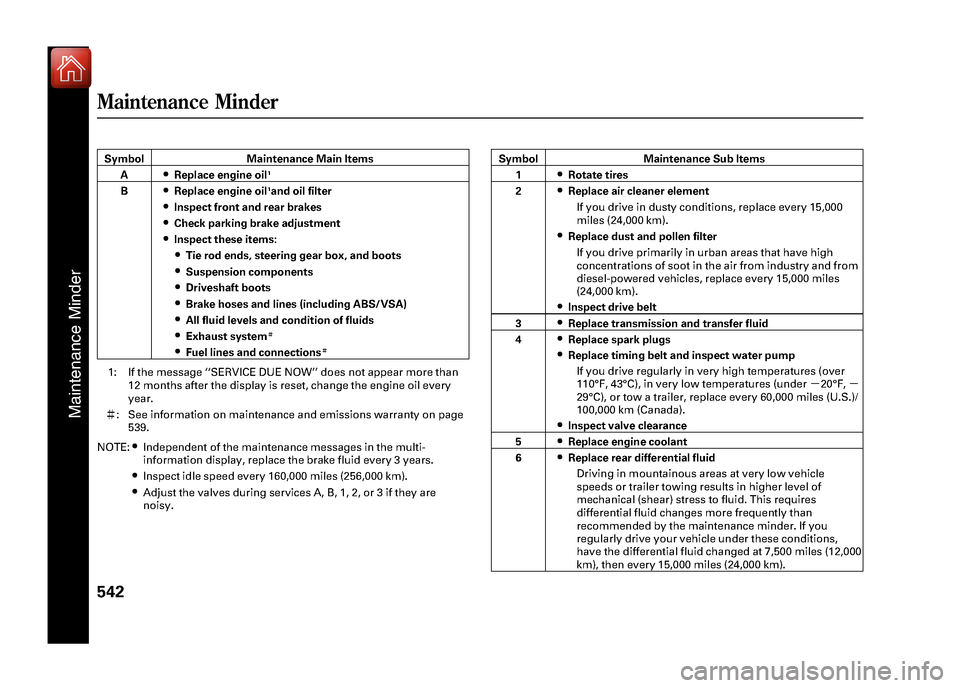
SymbolMaintenance Main Items
A
●Replace engine oil
1
B
●Replace engine oil
1and oil filter
●Inspect front and rear brakes●Check parking brake adjustment●Inspect these items:●Tie rod ends, steering gear box, and boots●Suspension components●Driveshaft boots●Brake hoses and lines (including ABS/VSA)●All fluid levels and condition of fluids●Exhaust system
#
●Fuel lines and connections
#
1: If the message ‘‘SERVICE DUE NOW ’’does not appear more than
12 months after the display is reset, change the engine oil every
year.
# : See information on maintenance and emissions warranty on page
539.
NOTE:
●Independent of the maintenance messages in the multi-
information display, replace the brake fluid every 3 years.●Inspect idle speed every 160,000 miles (256,000 km).●Adjust the valves during services A, B, 1, 2, or 3 if they are
noisy. Symbol Maintenance Sub Items
1
●Rotate tires
2●Replace air cleaner element
If you drive in dusty conditions, replace every 15,000
miles (24,000 km).●Replace dust and pollen filterIf you drive primarily in urban areas that have high
concentrations of soot in the air from industry and from
diesel-powered vehicles, replace every 15,000 miles
(24,000 km).●Inspect drive belt
3●Replace transmission and transfer fluid
4●Replace spark plugs●Replace timing belt and inspect water pump If you drive regularly in very high temperatures (over
110°F, 43°C), in very low temperatures (under -20°F, -
29°C), or tow a trailer, replace every 60,000 miles (U.S.)/
100,000 km (Canada).●Inspect valve clearance
5●Replace engine coolant
6●Replace rear differential fluid Driving in mountainous areas at very low vehicle
speeds or trailer towing results in higher level of
mechanical (shear) stress to fluid. This requires
differential fluid changes more frequently than
recommended by the maintenance minder. If you
regularly drive your vehicle under these conditions,
have the differential fluid changed at 7,500 miles (12,000
km), then every 15,000 miles (24,000 km).
Maintenance Minder
Maintenance Minder
54209/10/28 17:15:37 10 ACURA ZDX KA KC New North America Own 50 31SZN600 enu